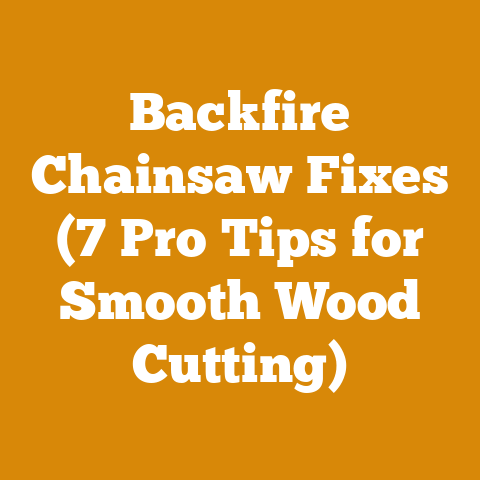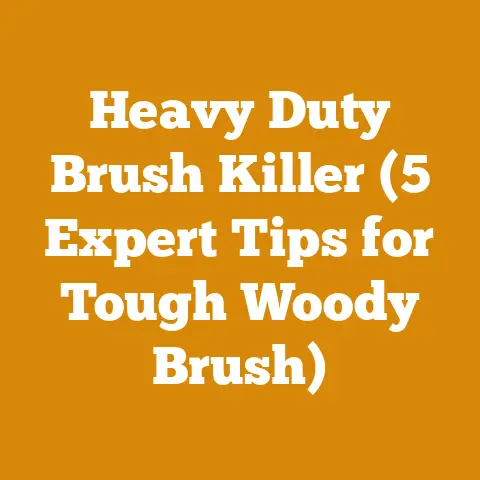Husqvarna 350 Chainsaw Chain Size (5 Expert Tips for Upgrade)
Let’s dive in!
My Husqvarna 350 Chainsaw Chain Size Journey: And How You Can Upgrade Yours
I remember the first time I ever used a chainsaw. I was about 16, helping my grandpa clear some fallen trees after a nasty ice storm. He handed me his trusty Husqvarna 350, and after a quick safety lesson (which I’m sure I only half-listened to), I was cutting. It felt powerful, almost rebellious. Of course, I quickly learned that chainsaw work is more about precision and patience than brute force. Over the years, that Husqvarna 350 became a constant companion. I’ve used it for everything from clearing brush to bucking firewood, and even some basic milling. One thing I’ve always tinkered with is the chain. Getting the right chain size and type is crucial for performance and safety. I’ve spent countless hours researching, experimenting, and learning from my mistakes. This guide is a culmination of that experience, specifically tailored for the Husqvarna 350. I’ll walk you through everything you need to know about choosing the right chain, upgrading for specific tasks, and keeping your saw running smoothly.
Understanding the Stock Husqvarna 350 Chain
Before we dive into upgrades, let’s establish a baseline. The Husqvarna 350 typically comes equipped with a chain that’s well-suited for general-purpose cutting.
- Pitch: This is the distance between any three consecutive rivets divided by two. The standard pitch for the Husqvarna 350 is .325 inches. This is a very common pitch for chainsaws in this size class, striking a good balance between cutting speed and durability.
- Gauge: The gauge refers to the thickness of the drive links, which fit into the groove of the chainsaw bar. For the Husqvarna 350, the gauge is typically .050 inches (1.3 mm). Using the correct gauge is vital for proper chain engagement with the bar.
- Drive Links: This is the number of links that fit into the chainsaw bar’s groove. The standard Husqvarna 350 chain typically has 72 drive links when paired with an 18-inch bar. This number will change if you use a different bar length.
- Cutter Type: Most often, the stock chain features semi-chisel cutters. These offer a good compromise between aggressive cutting and ease of sharpening.
Why These Specs Matter:
These specifications are not arbitrary. They’re carefully chosen to match the saw’s power output, bar length, and intended use. Using the wrong pitch or gauge can damage your saw and create a serious safety hazard.
My Experience:
I once tried to use a chain with the wrong gauge on my 350. The chain was too loose in the bar groove, causing excessive vibration and making it difficult to control the saw. I quickly realized my mistake and switched back to the correct gauge.
Takeaway: Always double-check the pitch, gauge, and drive link count before purchasing a new chain. Refer to your chainsaw’s manual for the correct specifications.
Expert Tip #1: Choosing the Right Chain Length for Your Husqvarna 350
The length of your chainsaw chain is directly related to the length of your chainsaw bar. While the Husqvarna 350 is often paired with an 18-inch bar, it can also accommodate bars ranging from 13 to 20 inches.
- Matching Bar and Chain: It’s crucial to match the chain length (number of drive links) to the bar length. Using a chain that’s too short will be obvious, as it won’t reach around the bar. A chain that’s too long will be loose and prone to derailment.
- Determining Drive Link Count: The number of drive links needed depends on the bar length. As mentioned earlier, an 18-inch bar typically requires 72 drive links. A 16-inch bar might need 66 drive links, while a 20-inch bar could require 78. Always consult your bar’s specifications or the chainsaw’s manual to confirm the correct number.
- Measuring Your Existing Chain: If you’re unsure of the drive link count, you can measure your existing chain. Count the number of drive links – the small, tooth-like projections that fit into the bar groove.
My Experience:
I once bought a used Husqvarna 350 that came with a mismatched bar and chain. The chain was too short for the bar, making the saw essentially unusable. I had to purchase a new chain with the correct drive link count before I could start cutting.
Why Bar Length Matters:
- Maneuverability: Shorter bars are easier to maneuver in tight spaces, making them ideal for pruning and limbing.
- Cutting Capacity: Longer bars allow you to cut larger diameter trees.
- Saw Power: Using a bar that’s too long can strain the saw’s engine, reducing its performance and lifespan.
Takeaway: Always use the correct chain length for your bar. Consult your chainsaw’s manual or the bar’s specifications to determine the required number of drive links.
Expert Tip #2: Upgrading to Different Chain Types
The stock chain on a Husqvarna 350 is a good all-around choice, but there are situations where upgrading to a different chain type can significantly improve performance.
- Full Chisel Chains: These chains have square-cornered cutters that are very aggressive and fast-cutting. They’re ideal for felling trees and bucking clean wood. However, they dull more quickly than other chain types and are more susceptible to damage from dirt and debris.
- Semi-Chisel Chains: As mentioned earlier, semi-chisel chains have rounded cutters that are more durable and forgiving than full chisel chains. They’re a good choice for general-purpose cutting, especially in dirty or abrasive conditions.
- Low-Kickback Chains: These chains are designed to reduce the risk of kickback, a dangerous phenomenon that can occur when the tip of the bar contacts an object. They feature guard links or bumper drive links that help to prevent the chain from grabbing and throwing the saw back towards the operator.
- Ripping Chains: These chains are specifically designed for cutting wood along the grain, such as when milling lumber. They have a different cutter geometry than cross-cutting chains, resulting in a smoother, more efficient cut.
My Experience:
I’ve experimented with all of these chain types on my Husqvarna 350. I found that full chisel chains were great for felling clean trees, but they dulled quickly when cutting near the ground. Semi-chisel chains were more versatile and held up better in dirty conditions. I always use a low-kickback chain when teaching beginners how to use a chainsaw. I’ve also used a ripping chain for milling lumber, and it made a huge difference in the quality of the cut.
Chain Type Selection Guide:
| Chain Type | Pros | Cons | Best Use |
|---|---|---|---|
| Full Chisel | Fast cutting, aggressive | Dulls quickly, susceptible to damage | Felling clean trees, bucking firewood |
| Semi-Chisel | Durable, forgiving, good all-around | Not as fast as full chisel | General-purpose cutting, dirty conditions |
| Low-Kickback | Reduced risk of kickback | Slower cutting | Beginner users, situations where kickback is a concern |
| Ripping Chain | Smooth, efficient cuts along the grain, ideal for milling | Not suitable for cross-cutting | Milling lumber |
Takeaway: Consider upgrading to a different chain type based on your specific cutting needs. Full chisel chains are great for speed, while semi-chisel chains offer durability. Low-kickback chains enhance safety, and ripping chains are essential for milling.
Expert Tip #3: Mastering Chainsaw Chain Sharpening
A sharp chain is essential for safe and efficient chainsaw operation. A dull chain requires more force to cut, increasing the risk of kickback and putting unnecessary strain on the saw’s engine.
- Identifying a Dull Chain: A dull chain will produce fine sawdust instead of chips, require more force to cut, and may cause the saw to vibrate excessively.
- Sharpening Tools: You’ll need a chainsaw file, a file guide, and a depth gauge tool. A vise to hold the saw securely is also helpful.
- Sharpening Technique: Use the file guide to maintain the correct filing angle and depth. File each cutter evenly, using smooth, consistent strokes. Pay attention to the depth gauge, which controls how deeply the cutter bites into the wood.
- Frequency of Sharpening: The frequency of sharpening depends on the type of wood you’re cutting and the conditions in which you’re working. A general rule of thumb is to sharpen the chain every time you refuel the saw.
My Experience:
I used to dread sharpening my chainsaw chain. I found it tedious and difficult to get right. However, I quickly realized that a sharp chain makes a huge difference in cutting performance and safety. I invested in a good file guide and learned the proper sharpening technique. Now, I sharpen my chain regularly, and it only takes a few minutes.
Sharpening Steps:
- Secure the chainsaw in a vise.
- Clean the chain with a wire brush.
- Use the file guide to maintain the correct filing angle and depth.
- File each cutter evenly, using smooth, consistent strokes.
- Check the depth gauge and file it down if necessary.
- Rotate the chain and repeat the process for all cutters.
- Inspect the chain for damage and replace it if necessary.
Advanced Sharpening Tips:
- Maintain Consistent Angle: Consistent file angle is the key to uniform cutter geometry.
- Depth Gauge Adjustment: Adjusting the depth gauge is critical for aggressive cutting.
- Chain Grinders: For high-volume sharpening, consider an electric chain grinder.
Takeaway: Learn how to sharpen your chainsaw chain properly. A sharp chain is essential for safe and efficient cutting. Sharpen the chain regularly, and inspect it for damage.
Expert Tip #4: Understanding Chain Maintenance and Lubrication
Proper chain maintenance is crucial for extending the life of your chain and ensuring optimal performance.
- Chain Lubrication: The chain needs to be constantly lubricated to reduce friction and prevent overheating. Use a high-quality bar and chain oil specifically designed for chainsaws. Check the oil level frequently and refill as needed.
- Chain Tension: The chain should be properly tensioned to prevent it from derailing or binding. The correct tension is when you can pull the chain away from the bar slightly, but it should still snap back into place.
- Cleaning the Chain: Regularly clean the chain with a wire brush to remove dirt, debris, and pitch. This will help to prevent premature wear and tear.
- Chain Storage: When not in use, store the chain in a container of oil to prevent rust and corrosion.
My Experience:
I once neglected to lubricate my chainsaw chain properly. The chain quickly overheated and stretched, causing it to derail frequently. I learned my lesson and now I’m diligent about chain lubrication.
Lubrication Best Practices:
- Use High-Quality Oil: Invest in a good quality bar and chain oil.
- Check Oil Level Frequently: Monitor the oil level and refill as needed.
- Adjust Oiler: Adjust the oiler to match cutting conditions.
- Consider Bio-Oil: Environmentally friendly bio-oils are a sustainable choice.
Tensioning Tips:
- Check Tension Regularly: Check chain tension before each use.
- Adjust Tension Properly: Adjust tension until the chain snaps back into place.
- Hot vs. Cold Tension: Tension will change slightly when the chain is hot.
Takeaway: Maintain your chainsaw chain properly by lubricating it regularly, tensioning it correctly, and cleaning it frequently. Store the chain in oil when not in use.
Expert Tip #5: Troubleshooting Common Chain Problems
Even with proper maintenance, chainsaw chains can sometimes experience problems. Knowing how to troubleshoot these issues can save you time and money.
- Chain Dulls Quickly: This could be due to cutting dirty wood, using the wrong chain type, or improper sharpening technique.
- Chain Derails Frequently: This could be due to improper chain tension, a worn bar, or using the wrong chain length.
- Chain Binds in the Cut: This could be due to a dull chain, insufficient lubrication, or cutting wood that is under tension.
- Chain Vibrates Excessively: This could be due to a loose chain, a damaged chain, or a worn bar.
My Experience:
I once had a problem with my chainsaw chain derailing frequently. I checked the chain tension, the bar, and the chain itself, but I couldn’t find anything wrong. Finally, I realized that the bar was worn and needed to be replaced. Once I replaced the bar, the problem was solved.
Troubleshooting Checklist:
- Chain Tension: Ensure proper chain tension.
- Bar Condition: Inspect the bar for wear and damage.
- Chain Sharpness: Sharpen or replace the chain if dull.
- Lubrication: Verify adequate chain lubrication.
- Drive Sprocket: Check the drive sprocket for wear.
- Chain Type: Ensure the chain type is appropriate for the task.
Case Study: Resolving Chain Binding
I worked with a local logger who was experiencing frequent chain binding when felling large oak trees. After analyzing the situation, we determined that the chain was dull and the bar oiler was not functioning properly. We sharpened the chain, adjusted the bar oiler, and the problem was resolved.
Takeaway: Be able to troubleshoot common chainsaw chain problems. Check the chain tension, bar condition, chain sharpness, lubrication, and drive sprocket.
Beyond the Basics: Advanced Chain Considerations for the Husqvarna 350
Once you’ve mastered the fundamentals, you can start exploring more advanced chain options and techniques to further optimize your Husqvarna 350’s performance.
- Narrow Kerf Chains: These chains have a thinner cutting width, requiring less power to cut. They can be a good choice for smaller saws like the Husqvarna 350, especially when cutting hardwoods.
- Skip Tooth Chains: These chains have fewer cutters, resulting in a faster cutting speed. However, they can be more prone to vibration and kickback.
- Carbide-Tipped Chains: These chains have carbide-tipped cutters that are extremely durable and can hold their edge for much longer than standard steel cutters. They’re ideal for cutting abrasive materials like dirty wood or roots.
My Experience:
I’ve experimented with narrow kerf chains on my Husqvarna 350 and found that they did make a noticeable difference in cutting speed, especially when bucking larger logs. I’ve also used carbide-tipped chains for cutting roots and stumps, and they held up much better than standard chains.
Specialized Chains:
- Ice Chains: For cutting frozen wood or ice.
- Concrete Chains: For cutting concrete or asphalt (requires specialized saw).
- Rescue Chains: Designed for cutting through various materials in emergency situations.
Chain Selection for Specific Wood Types:
- Softwoods (Pine, Fir): Full chisel or semi-chisel chains work well.
- Hardwoods (Oak, Maple): Narrow kerf or carbide-tipped chains are recommended.
- Frozen Wood: Ice chains are essential.
Takeaway: Consider exploring advanced chain options like narrow kerf chains, skip tooth chains, and carbide-tipped chains to further optimize your Husqvarna 350’s performance. Choose the right chain for the type of wood you’re cutting.
Safety First: Always Prioritize Safe Chainsaw Operation
Chainsaw operation can be dangerous if proper safety precautions are not followed. Always wear appropriate personal protective equipment (PPE), including a helmet, eye protection, hearing protection, gloves, and chainsaw chaps.
- Personal Protective Equipment (PPE): Always wear appropriate PPE when operating a chainsaw.
- Safe Cutting Techniques: Use proper cutting techniques to avoid kickback and other hazards.
- Chain Brake: Always engage the chain brake when the saw is not in use.
- Emergency Shut-Off: Know how to quickly shut off the saw in an emergency.
- Clear Work Area: Keep the work area clear of obstacles and bystanders.
My Experience:
I’ve had a few close calls while operating a chainsaw. One time, I was cutting a small tree when it unexpectedly sprung back and nearly hit me in the face. I was wearing a helmet and eye protection, which prevented serious injury.
Safety Checklist:
- Read the Manual: Familiarize yourself with the chainsaw’s manual.
- Inspect the Saw: Inspect the saw before each use.
- Wear PPE: Always wear appropriate PPE.
- Use Proper Techniques: Use proper cutting techniques.
- Stay Alert: Be aware of your surroundings.
Takeaway: Always prioritize safety when operating a chainsaw. Wear appropriate PPE, use proper cutting techniques, and be aware of your surroundings.
Final Thoughts: Mastering Your Husqvarna 350 Chainsaw Chain
Choosing the right chain for your Husqvarna 350 is a critical factor in maximizing its performance, ensuring your safety, and extending the life of the tool. From understanding the stock chain specifications to exploring advanced options and mastering maintenance techniques, I’ve shared the insights I’ve learned over years of hands-on experience. Remember, a well-maintained, properly chosen chain not only makes cutting easier and more efficient but also significantly reduces the risk of accidents.
I encourage you to experiment with different chain types and sharpening techniques to find what works best for your specific needs and the types of wood you typically work with. And most importantly, always prioritize safety. With the right knowledge and practices, your Husqvarna 350 can be a reliable and valuable tool for many years to come. Now, go out there, cut safely, and enjoy the satisfaction of a job well done!






